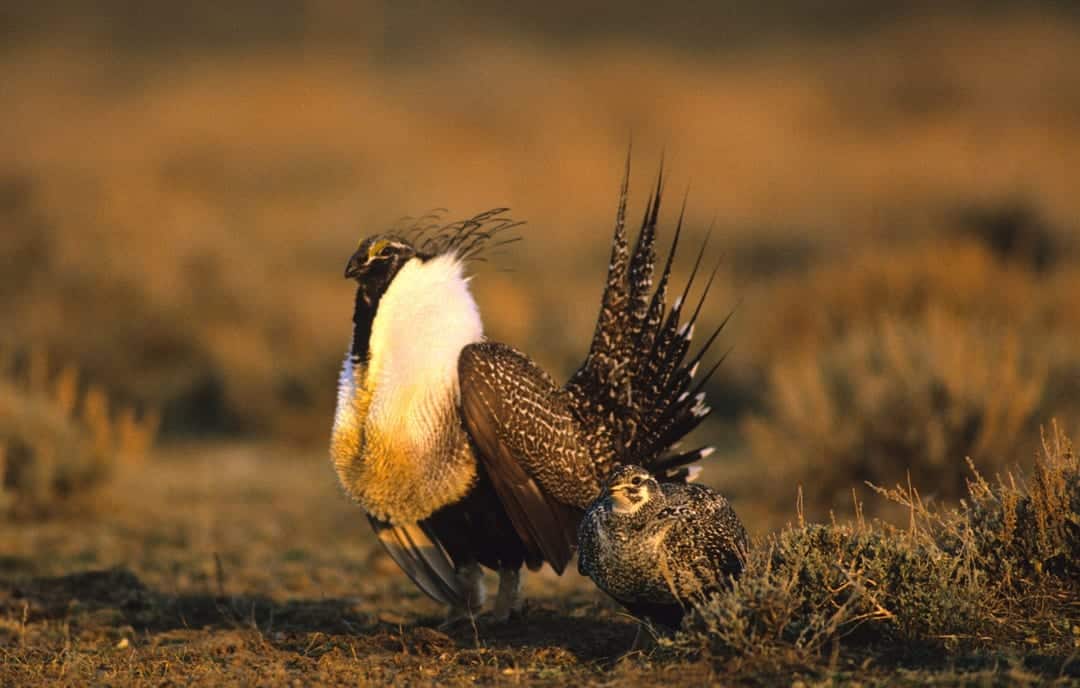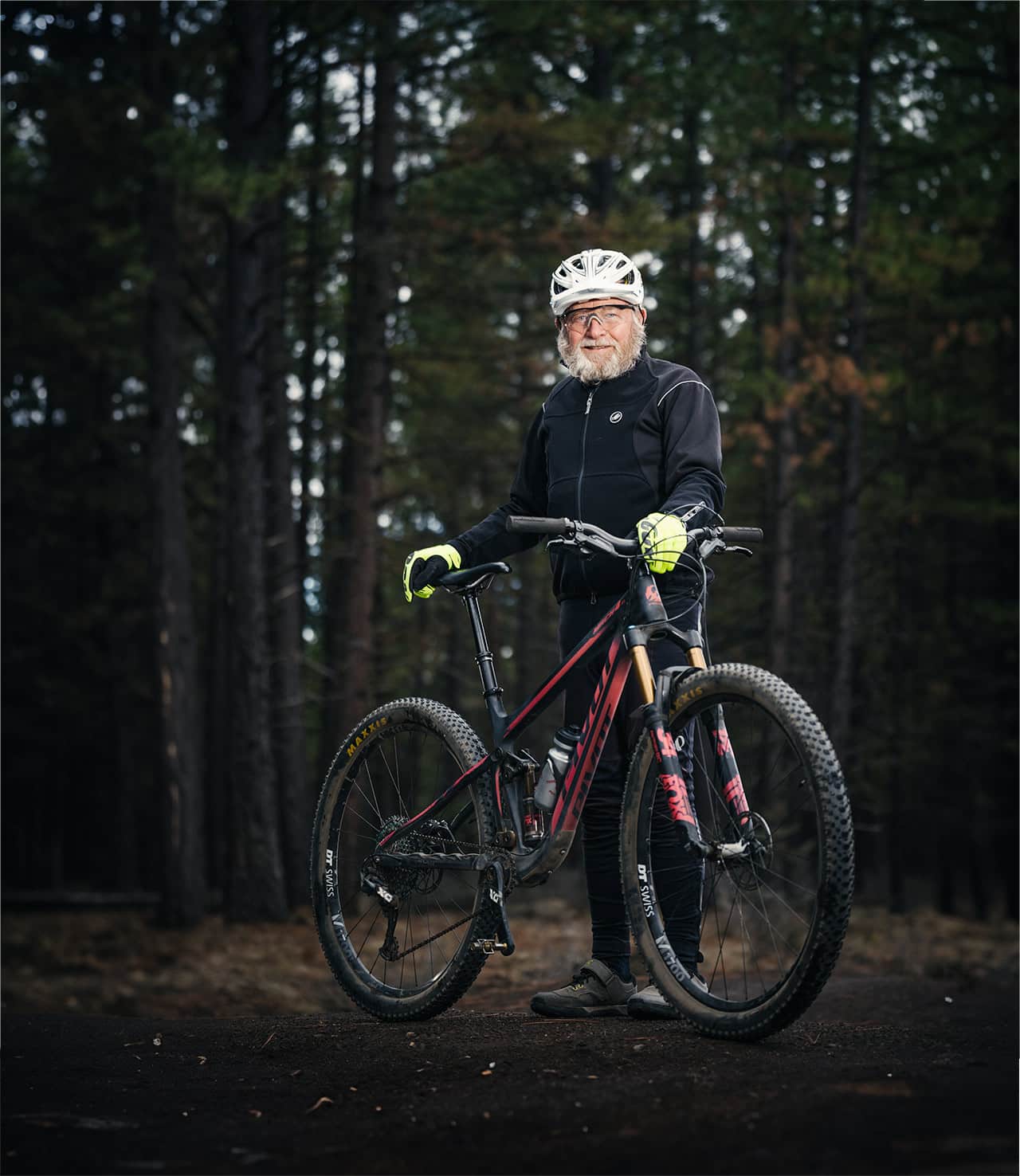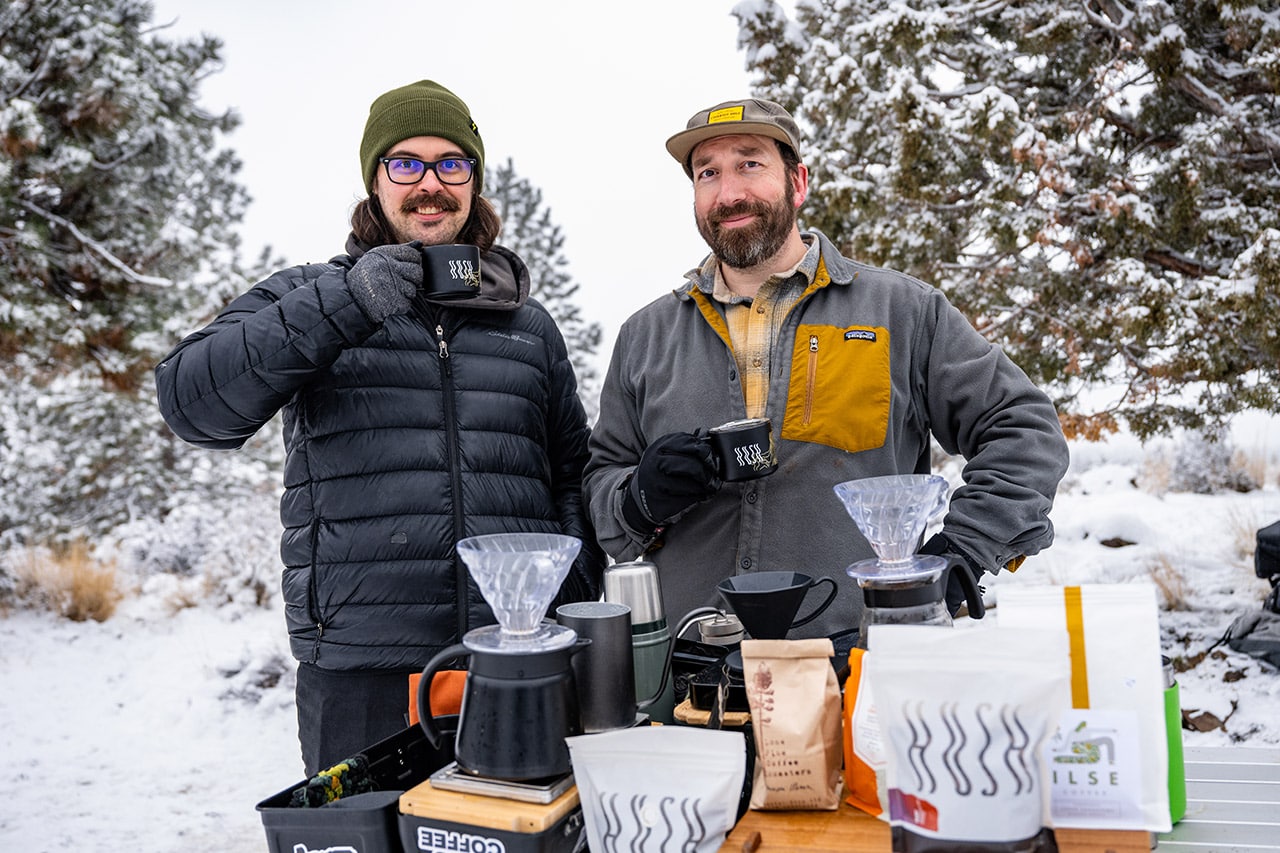In 2015, the American West reached an unprecedented environmental compromise to protect the greater sage grouse, a high desert bird with a drastically declining population. Two years later, the rug was pulled out from that plan, leaving an environmental community fuming and the small bird’s fate in question.

I looked out the back window of the truck and could see the last stars were still out. Below them, a faint outline of the mountains that surrounded us appeared in the distance. It was a little before 6 a.m. on an early spring day, and four of us were driving in a pickup truck along the winding frozen gravel roads of Hart Mountain National Antelope Refuge in Southeastern Oregon. Another passenger, Pam, was counting down the miles on our GPS so the driver, her husband Chris, would know when to slow down.
Through a series of miscommunications due to a lack of sleep, minimal coffee and sheer darkness, we were late getting through the U.S. Fish and Wildlife gate and still had a little more than five miles to drive to our stopping point, all before starting the mile-long hike through rugged sagebrush country to find our destination before first light. After reaching our stop, we bundled in layers of wool, puffy jackets and hats, quickly hopped out of the truck and started the trek.
Headlamps on and heads down, we navigated the frosted sagebrush, grass and rocks. I risked a few glances of the first hint of light creeping up over Beatys Butte in the distance, careful not to take my eyes off the ground for too long. Following our GPS, we hiked along a rock ridge, then scrambled up it and over, before the last quarter-mile over the lava rocks.
Finally, Chris stopped and set down his scope. We confirmed our location in hushed voices around the GPS, then took a moment to marvel at the sunrise and the 360-degree view of golden grass that tumbles over what is called the sagebrush sea. We brought our binoculars to our eyes and started scanning about 200 yards ahead. Sarah spotted the trademark white chest puffing up and down, then the unmistakable spiked and fanned feathers. A sage grouse. Then another bird is spotted. And another. We reached the lek. And I finally witnessed the thousands of years old mating ritual exclusive to the high desert.
We were far enough away for the sage grouse not to notice us watching. Unbeknownst to the sage grouse, much of the American West is also watching the small bird right now, as it is at the epicenter of a political controversy over public lands that spans across the high desert.
Rite of Spring
Chris and Pam Scranton are both retired teachers and have lived in Madras for twenty-two years. They saw the greater sage grouse for the first time in Millican, about twenty miles east of Bend, in 1995. They would stop there on their way to Eastern Oregon with their children to see the sage grouse at their leks each year. “Nobody was there, just us,” said Pam. “It felt like a rite of spring.”
From the Swedish verb meaning “to play,” a lek is sage grouse mating ground, usually found in a specific habitat in sagebrush country. Pam, Chris and their three children would watch the sage grouse, about the size of a large chicken, “display”, the scientific word for the puffed chests and fanned feathers strut that the male sage grouse do to impress females and, ideally, breed.
Chris said they saw about fifty males displaying the first time they went. Over the years, as word got out and more people arrived each spring to watch, the bird numbers dwindled as people got too close and the sage grouse stopped returning. “It’s not because [visitors] wanted to disturb them, I just don’t think they understood,” said Chris. Soon, due to the habitat disturbance, as well as other changes to the sagebrush steppe, the lek was gone. “It was rather sad to see it decline to the point of nothing.”
Chris and Pam were two of twelve volunteers on a three-day trip to count sage grouse in Hart Mountain with the Oregon Natural Desert Association (ONDA), a Bend-based nonprofit that works on public land and conservation issues east of the Cascades. The conservation of sage grouse is one of those issues, and one that, three years ago, had largely been resolved, or at least was on its way to be.
Fowl Politics
The Millican situation was unique because the leks were close to the highway and easily accessible to the public, but it is also a microcosm of what has happened to sage grouse across their historic range. It’s been a decades-long saga that has pushed them to the brink of extinction and to the forefront of a political battle over the intersection of private interest and public lands.
In 2015, a landmark environmental compromise was reached by almost every interest group, government agency and nonprofit that has a stake in public land throughout the eleven Western states. It was an unprecedented moment for wildlife conservation, said Paul Henson, the State Supervisor of U.S. Fish and Wildlife in Oregon. Henson has been involved with sage grouse almost the entirety his twenty-five years with the government agency in charge of habitat and wildlife monitoring.
The sage grouse saga began ten years earlier in 2005, when the sage grouse populations across the West were low enough for conservation groups to petition for the ground-nesting birds to be added to the Endangered Species List. The listing would have added broad protections for the species across the Western states where it is still found, but that was opposed by an alliance of farmers, ranchers and Western politicians. After a review, U.S. Fish and Wildlife determined a listing wasn’t warranted, but the agency “recognized that there was certain conservation concerns for sage grouse and sagebrush habitat that needed to be addressed,” said Henson.

That decision was challenged by the environmental community, and between 2010 and 2015 a new management plan was created to address the threats to the species. “In Oregon and the other ten states, everyone rolled up their sleeves with sincere and good faith effort and developed plans at a federal level and the state level,” said Henson. Private landowners also played a key role in developing the plans, as a portion of sage grouse habitat is on ranches throughout the West.
At the end of it all in 2015, then Secretary of the Interior Sally Jewell recommended that the species did not merit an endangered species listing—if the plans were carried out. Though this sage grouse plan was not perfect, as I would be told countless times, it was considered a win for everyone involved, and for the sage grouse. Oregon Governor Kate Brown adopted Oregon’s version of the plan. After the celebrations faded, the work began and the sage grouse plan moved forward into implementation.
Then in the fall of 2017 things began to unravel. Ryan Zinke, a square-jawed former University of Oregon football player and Navy SEAL turned Montana congressman was appointed as Secretary of the Interior by the Trump administration. An avid outdoorsmen who had been endorsed by several environmental groups earlier in his political career, Zinke was charged with reviewing some of conservation plans rolled out during the Obama administration. Zinke wasted no time. He soon announced that the sage grouse plans, and a decade of work, would be reviewed and potentially amended. It came on the heels of Zinke’s plan to shrink several national monuments in the West such as Bears Ears in Utah and Cascade-Siskiyou in Southern Oregon, with the potential for increased mineral and resource extraction.
You could almost hear the collective sigh that reverberated across the West.
The Bird is the Word
About six months later, I arrived at Hart Mountain, a four-hour drive from Bend, in the afternoon on a clear day, though the smattering of snow on the roads reminded me that our late winter was far from over, despite the calendar inching forward. The wildlife refuge was established in 1936 to protect the American pronghorn, which gallop across the range in herds, but it shelters countless more species that have since declined in other spaces across the West. Part of its success is its sheer size. At 422 square miles, Hart offers critical habitat that spans from buttes to playa lakes to wide expanses of sagebrush and protects hundreds of plants and animals, including sage grouse.
I walked into the Oregon Department Fish and Wildlife bunkhouse to find the group of volunteers gathered. The sparse bunkhouse was a recent addition to the refuge, which has a handful of other offices and cottages from the 1930s, built to house seasonal wildlife biologists doing data collection and volunteer groups like ONDA. The tone of the trip was largely excited, perhaps a little uncertain. Some, like Pam and Chris, had experienced counting sage grouse before. Others in their twenties trying to break into a wilderness career were there to gain field experience. There were avid birders and outdoorsmen, and a couple retired science teachers. We were there to count sage grouse leks for a weekend as volunteers for U.S. Fish and Wildlife. It’s an easy enough task, save for the 4 a.m. alarms and frigid temperatures.
Sarah Imholt, 40, joined the trip. She’s a librarian at Oregon State University and described herself as a “bird person.” This trip was the first time she saw a sage grouse lek. “I got too excited and couldn’t do any counting for awhile,” she said after coming back from the first morning of data collection. “You can hear them making the glooping sounds. They’re just puffing their chests out and their tails are totally fanned out. They’re moving like little tanks, just struttin’ around.”
The greater sage grouse fits in well with sagebrush landscape. Their dark feathers stretch to their feet, and their white and brown speckled tails spike up in contrast to the yellow bunches of grass. The white chests, distinctly a feature of the males, puff up and make a sound like large drops of water when they fill up with air, and the grouse will sometimes bump their chests into each other while sparring at the leks to impress females.
“Sage grouse lekking behavior is one of the most magnificent natural phenomena we have in Southeastern Oregon,” said Lee Foster, the sage grouse conservation coordinator for Oregon Department of Fish and Wildlife (ODFW). Sage grouse leks are important because the birds return to them year after year for generations. “There’s a lek in Idaho that goes back eighty years. Some of those older leks have indications that Native Americans were hunting those leks,” said Foster.
One of the reasons sage grouse have become the poster child for sagebrush conservation is that their leks, set in wide open spaces on the ground among sagebrush, make them easy to spot and their populations easy to monitor. It also makes them susceptible to natural predators like ravens, golden eagles, bobcats and coyotes. “They really face every predator out there,” said Foster.
Sage grouse also need certain grasses native to sagebrush country as well as large swaths of uninterrupted habitat because they migrate between those areas, with a range in Oregon that has been documented at up to thirty miles. This is all to say that a variety of factors need to combine and work in harmony for sage grouse to thrive. If sage grouse are thriving, it’s a good indication that the 350 other species, animal or plant, that inhabit sagebrush country are thriving and the ecosystem is healthy. But as the high desert in the West has been infiltrated and exploited, new threats have arisen, and sage grouse are far from thriving.
Home on the Range
There are currently fewer than 500,000 sage grouse in the West, down from an estimated 16 million before the decline began in the mid-20th century. That’s a 97 percent decline in just a little over half a century. The primary reason is a dwindling habitat due to a trio of factors that all play into each other: invasive annual grasses, the encroaching juniper on lower elevation areas and wildfire.
Those three factors have contributed to the overall decline of the sagebrush ecosystem. Of the pre-settlement 153 million acres of sagebrush steppe, 106 million acres currently exist. Home to more than 350 species of flora and fauna, the high desert country is a vast landscape of varieties of sagebrush and sage grouse, but also wildflowers, American pronghorn, golden eagles, pygmy rabbits, coyotes, juniper and more. The ecosystem’s decline is pinpointed on overgrazing and introduced species of plants like cheatgrass that combined allow for more frequent and devastating wildfires. It’s considered one of the most imperiled ecosystems in North America, according to U.S. Fish and Wildlife.
The 2015 sage grouse management plan wouldn’t have reversed the decline of the sagebrush steppe, but it would have helped to preserve what remains. For some in the conservation community the plan didn’t go far enough.
“In the end, it was a marginally acceptable package of political compromises on what is effectively a scientific effort to do species conservation,” said Dan Morse, the conservation director of ONDA. Zinke’s announcement essentially put the conservation plans in limbo and was especially upsetting to groups like ONDA.
“The plan that came out in 2015 was far from perfect,” said Morse. “From our perspective there were things that could have been stronger for sage grouse conservation, but that if it were implemented rigorously and quickly, then it might be adequate for conserving a species. When these more recent plans to re-amend the sage grouse plan came out, we were very disappointed and frustrated that effectively the deal that had been reached was being re-negotiated by certain interests.”
In Oregon, much of the negotiations were with landowners and ranchers in Southeastern Oregon who rely on public lands to graze their cattle. Tom Sharp is the president-elect of the Oregon Cattlemen’s Association and has worked on the sage grouse issue for almost a decade providing conservation efforts on private lands, particularly in southeastern Oregon. For ranchers, the stakes in coming to a compromise about sage grouse and preventing a listing were high.

“If we thought what happened to the timber industry in the 1980s was bad,” said Sharp, referring to the controversy over the Northern Spotted Owl Endangered Species listing, “well, it would be an order of magnitude greater with the sage grouse listing.” Sharp acknowledged that the ranchers were somewhat reluctant to forge an agreement with the federal government over the plans, but were largely on board to avoid a listing. The oft-cited mantra was, “What’s good for the bird is good for the herd.”
Andrew Shields, a wildlife biologist for Roaring Springs Ranch in southeastern Oregon, echoed Sharp’s statements. “Ranchers push back on some of these plans,” said Shields. “It’s not because they don’t like sage grouse or healthy rangeland, it’s because they’re so tied to the land and they care deeply about the land and wildlife, and a lot of the time, the things they’ve done work. That’s why there’s sage grouse there.”
In early May, the BLM released the draft environmental impact statement for sage grouse management and habitat. Overall, there were minimal changes to Oregon’s sage grouse conservation plan. In Oregon, a total of 22,000 acres, an area roughly the size of the city of Bend, previously designated as research natural areas, would be open for livestock grazing. From an environmentalist perspective, it fared better than other states such as Nevada, Wyoming and Idaho, which now may face more oil and gas drilling potential, development identified as a key threat to sage grouse. The BLM is accepting public comments until August 2 on the plan.
The proposed amendments are welcomed by Oregon’s cattle industry. “We believe that a reconsideration to amend these federal plans is necessary based on new science that came out that says properly managed livestock grazing is not a threat to sage grouse but can be compatible or beneficial to sage grouse species,” said Sharp. Not everyone agrees that grazing can be a benefit to sage grouse, but most scientists say that grazing, done properly, doesn’t have to interfere with sage grouse populations.
Given that the sage grouse is a rangewide species, meaning that its habitat crosses state lines, the federal consistency of the sage grouse management plan was integral to the success of the bird. These amendments coming state by state threaten that.
“[The federal plan] has a degree of consistency across the range,” said Morse. “If we decrease that consistency, we are doing what science tells us not to do.”
Conservationists are already pushing back. In late April, environmental groups sued the current administration for allegedly ignoring sage grouse protection policies and selling oil and gas leases in 475 square miles in Montana, Wyoming, Utah and Nevada. If the administration continues to prioritize energy development to the point that threatens more habitat on public land, it wouldn’t be surprising to see more lawsuits in the future.
At The Hart Of It
In Oregon, where there is less pressure to develop gas leases, the partnerships have more or less remained intact. Henson at U.S. Fish and Wildlife pointed out while the the political back and forth is common, the people on the ground keep moving forward. “The biggest message is even through an election and through some of the other challenges we’ve had like the Malheur occupation, where there was a lot of emotion and political acrimony, the partnership in Oregon for sage grouse conservation has remained really strong.”
Camped out in the pre-dawn hours on Hart Mountain, waiting patiently for an elusive bird to appear from the darkness, the politics of the sage grouse fight can feel a world away. “The fundamental reason [I joined this trip] is I spend a lot of time outdoors. It’s an important part of my life. The landscape, the things on this landscape—I value it. I want people to value it,” said Sam Miller, a retired science teacher from Eugene. “I don’t want to get too political here. I’m trying to find a way to say it without flames coming out of my mouth,” he continued while we were talking at Hart Mountain. “Our votes matter because ultimately that translates to the leadership we either have, or don’t have, and the direction that leadership takes. If we care about these kinds of places, then we need to make sure we support people who have that point of view.”
If sage grouse populations don’t return, it doesn’t mean that just another species of bird is lost. It means the sagebrush steppe—an entire ecosystem—has been lost. It means that millions of acres of high desert country have become vulnerable to the epic wildfires that have the potential to devastate the landscape, homes, economies and cities. It’s a lot of weight on the wings of one bird.
Witnessing sage grouse at the lek “feels really lucky,” said Imholt. “[Sage grouse] have been doing this for God knows how many thousands of years and they’re still doing it even though we’re screwing everything up around them.” At Hart Mountain at least, “this little sphere of existence is right, and these little birds are doing what they are supposed to do,” she said.
We woke up on the last morning to five inches of snow on the ground and a bluebird sky. By the time my group had reached the last lek, the birds there had already moved on, perhaps flushed out by the coyote we spotted in the distance. There was still evidence of their dance written on the snow—light touches of wings moving around in circles and patterns left behind in the last snowfall of the season where their feathers had dragged. The sage grouse would probably return to the lek to do their dance again the next morning, and hopefully their next generation would return the following spring. Our only job is to give them the space to continue and the chance to keep coming back.







